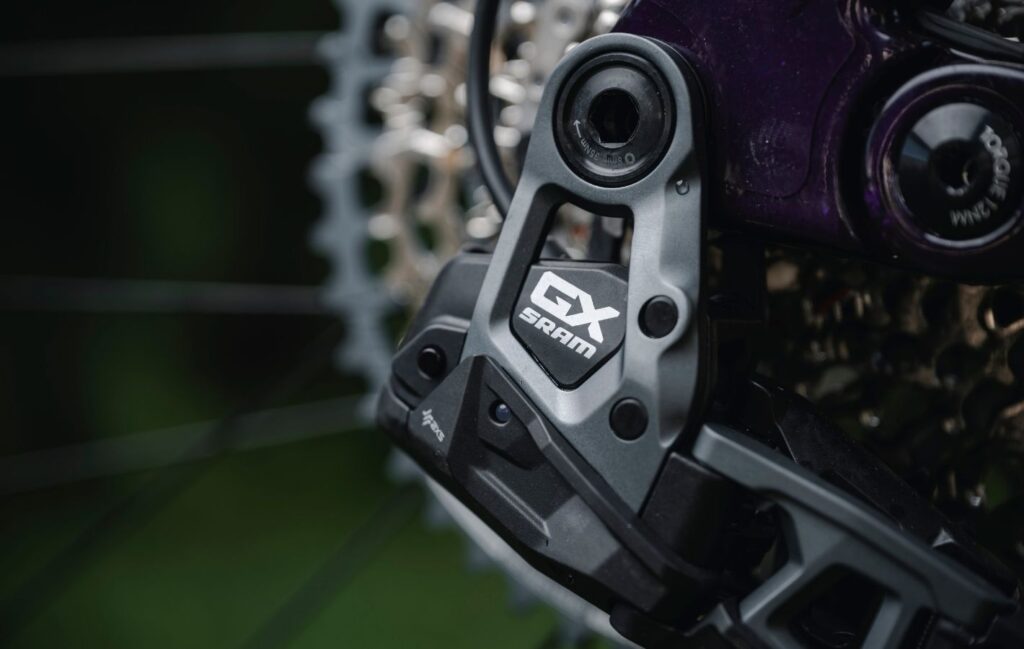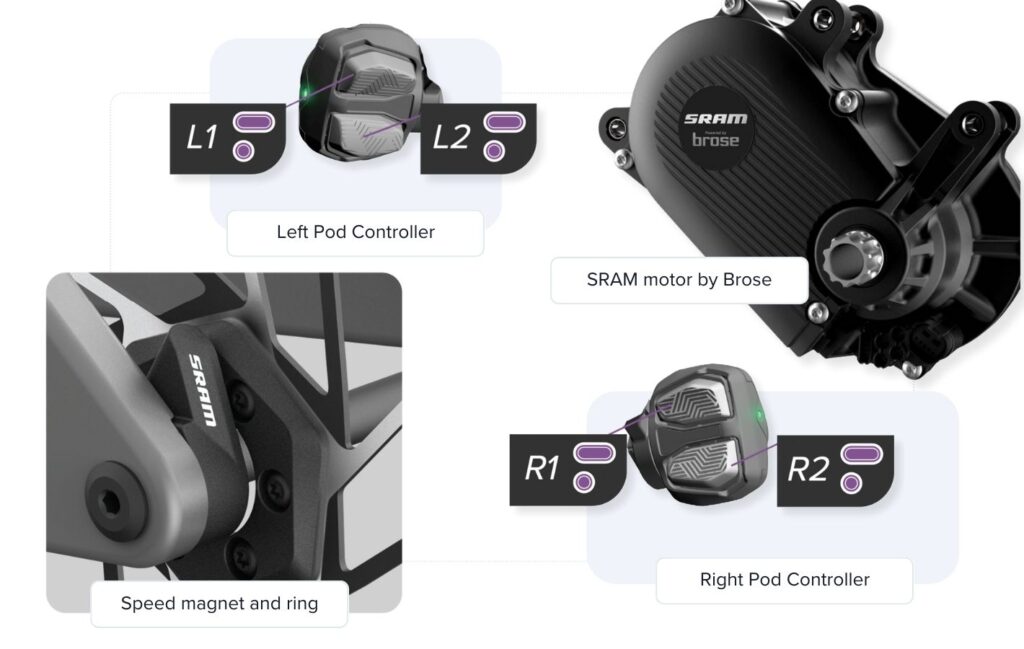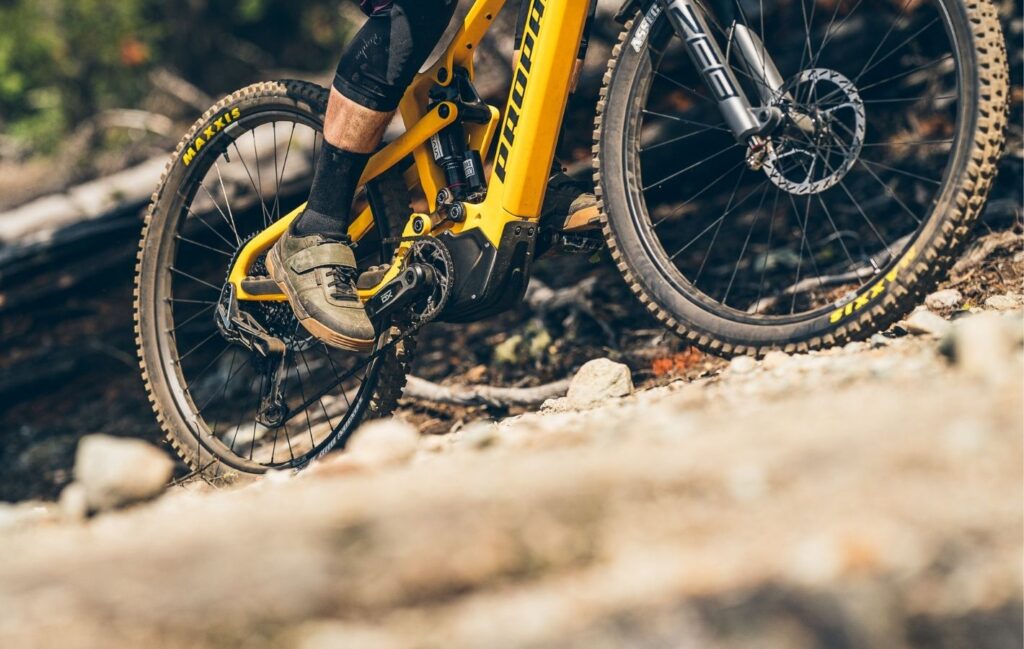SRAM has unveiled its new e-bike motor system, specifically designed for off-road e-bikes, marking one of the most noteworthy developments in motor news in recent years. We’ve had the opportunity to test this innovative system and experience its intelligent auto-shift functionality firsthand.

SRAM is one of the largest component suppliers in the cycling space for electric and analog bikes. They produce drivetrains, sprockets, chains, derailleurs, brakes, forks, suspension components, wheels, bars, and stems. Building almost a whole bike, apart from the frame, using SRAM components is possible. This is significant, as they have relationships with nearly every bike producer globally, which means they have pre-aligned business channels to allow companies to easily start using their motors.
Until now, the big three, Bosch, Shimano, and Yamaha, owned most of the quality e-bike market motor pie. SRAM launching is a significant threat to these companies.
SRAM Eagle Powertrain Specifications
SRAM system includes its own battery, Brose motor (with proprietary software), display, remotes, and integrated shifting.

These components work harmoniously. Here’s how:
- The power is delivered using a SRAM T-type cassette and chain.
- The shifting is directly connected to the motor function with an auto-shift function.
- The motor has 90 Nm of torque, which is market-leading, and 250 watts of power, powered by a 720 Wh battery using the latest 21700 cell technology. (A smaller 620 Wh battery will also be available.)
- The auto-shift feature, using a wireless Eagle 12-speed derailleur, maintains a specified cadence uphill while the coast shift automatically selects the correct gear downhill based on bike speed.
- The clear HD display, mounted on the top tube, shows power mode, battery level, auto-shift status, and features ant+.

The system offers two tunable power modes, Range and Rally, controlled via the AXS app and two wireless pods on the bar, allowing customization of shifting, power selection, and seat post activation. The system is based on a reliable Brose motor, seen as a starting point with SRAM working on developing its motor systems. The battery integrates seamlessly into the downtube, secured by a single bolt on the Nukeproof test bike, and connects with a magnetic plug for simplicity.
- SRAM Drive Unit: Power 250W
- Torque: 90 Nm
- Battery: SRAM 720 Wh
- Motor weight: 6.1 lbs
- Power modes: Two Range and Rally
- Display: AXS Bridge display.
- Remotes: SRAM Pod Controllers
- App: SRAM AXS
- External displays: ANT+
On The Trail
The motor is pedal assist only. There is no throttle, so this is a Class 1 system. The motor is activated by pedaling the bike. We tested the system on a Nukeproof Mega Watt, one of four bike companies launching with this system.
The first pedal strokes give a solid feeling with a smooth yet purposeful surge of power. Immediately if the bike detects it is in the wrong gear for the environment, it shifts. As you pedal up to speed, we noticed the motor shift again to match the rider’s cadence to the bike speed. Our first movement was to the trailhead on an asphalt road. This was an ideal opportunity to play with the auto-shift mode and power modes. There was a slight climb and we felt that the Rally power mode gave us the right amount of support, the motor kept a steady cadence of around 75 rpm and we noticed the gears shift silently, always keeping the bike moving at a constant speed as the hill’s steepness increased.
By pushing and holding the right upshift gear shift button, the display allowed us to change the auto-shift sensitivity from -3 to +3. We chose +2 after some experimentation as the right setting for keeping a relatively fast cadence of around 80 RPM in most conditions.

Once on the trail, the bike automatically adjusted to changes in terrain, shifting to easier gears for steep ascents and harder gears for flat sections, maintaining speed with consistent pedal pressure. The intelligent motor assistance provided notable support, enabling effective climbing over steep hills.
At the top of this short climb, the trail flowed downward, and we started to coast along at 15-20 mph. In this condition, we looked down and could see, even though our pedal arms were static, the front chain wheel was spinning and the gears were shifting into a harder gear. This is the coast-shifting feature. We started pedaling, and the bike speed matched our selected gear!
We experienced an off-road trail’s varying terrains and technical corners, with the bike handling all shifting automatically and efficiently. The automatic gear selection was nearly flawless uphill and accurate 80 percent of the time downhill, responding intelligently to the sensed environment. Even when we manually overrode the gears, the system was responsive, allowing quick adaptations to sudden trail changes and difficult situations without resistance.
After thorough testing, we found the coast-shifting feature extremely valuable, especially during focused downhill rides on technical trails; the SRAM system autonomously ensured optimal gear engagement. The new T-Type chain system was smooth, quiet, and free from the strain typically experienced with previous drive train generations. It can easily support the motor’s 95 Nm of torque.
The enhanced walk mode, facilitated by a high-resolution speed sensor, provided superior and immediate engagement when pushing the bike uphill, surpassing other systems we’ve encountered. This refined speed-sensing also contributes to the precise power measurement and accurate motor shifting.
Final Thoughts
While our experience with the motor system was limited to a few hours, we tried some gnarly trails. We pedaled up about 1,800 feet (600 meters) of altitude and used 30 percent of the 720 Wh battery capacity. Therefore the SRAM Eagle drivetrain is in line with the best systems on the market at about 40 miles on a full charge or around 6,000 feet of climbing.

The user can switch to Range mode and tune inside the AXS app to ensure the motor uses minimal power if absolute range is the most critical factor. Otherwise, the system’s power management is really good, and the motor is very quiet.
The SRAM motor system is very simple to use. One button to control the power modes, two buttons for shifting, and a long press to change the auto-shift sensitivity and turn it on or off whenever you want.
This system is poised to enhance the pedaling cadence and motor efficiency for beginner and intermediate riders, adeptly meeting the needs of experienced riders. We foresee future upgrades possibly eliminating manual gear thinking. The coast-shift and auto-shift functionalities are notably advantageous for skilled e-bike riders during downhill rides and technical climbs.
SRAM is poised to be a leading motor maker, initially offering this technology on higher-priced e-bikes, but we predict the system’s features will eventually be available in lower-priced ranges, potentially setting a new standard in the market.



